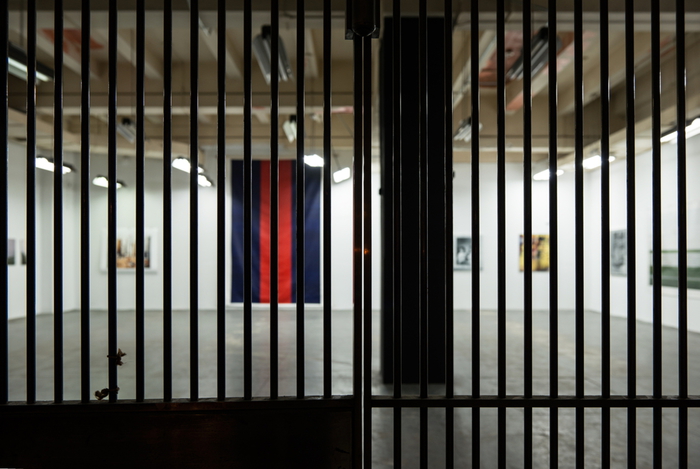
It’s been a hard season to think of positive things, and sometimes looking back, it’s been difficult to see how or if things mattered at all. But I also look back at the year with immense gratitude, both for the opportunities I’ve had, but also for the people who helped make them possible. I’d probably still be doing a lot of what I’m doing here if no one else was paying attention; that’s how it often feels, actually. But I’ve come to know that sometimes people do take an interest in what I’m doing, whether writing, research, criticism, or artmaking, and they respond to it, react to it, challenge it, run with it, join in on it. And it makes it interesting, better, and more meaningful, and it is nice to feel that. But there are also things, some of my greatest, favorite things, that would not have existed at all without the interest, effort, and support of others.
So I’d like to give some specific thanks to some of the many people who engaged with and supported my work in 2016. Without them, these things I am so proud of would literally not have happened.
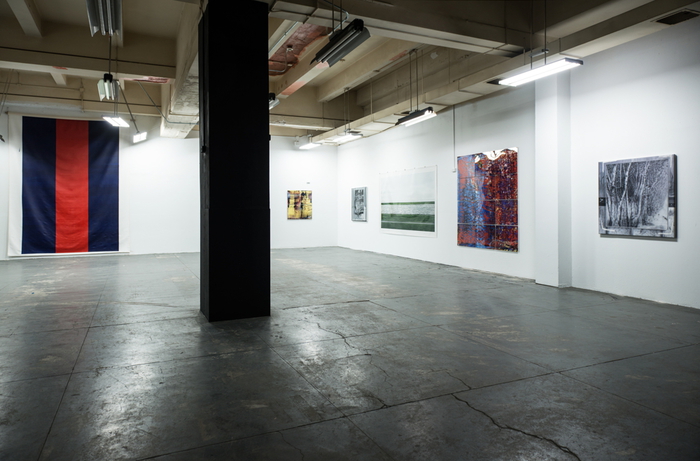
Magda Sawon suggested we do a proposal for SPRING/BREAK. “Chop Shop” began as a glib sendup of Simchowitzian cash&carry speculecting. But in the last few weeks before the show, it grew exponentially in scale, which forced some real thinking about its meaning and ambition. With Ambre & Andrew’s flexibility, and the extraordinary efforts of Magda’s posse, Chop Shop somehow became what supposed to not be: a Basel-ian boothful of investment-grade masterpieces. [Some of which are still available, btw. Get in now at 2016, pre-boom prices.]
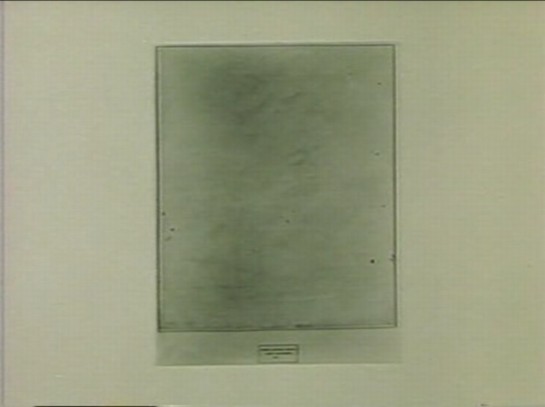
Book deals come and go, but Jennifer Liese and her colleagues at Paper Monument offered what bloggers need most: a good editing. When PM first asked to include my 2+ years of posts about the history of Erased deKooning Drawing in their anthology Social Medium, I frankly thought they were nuts. But Jen’s vision and thoughtful editing helped me see my own writing and ideas anew, and she enabled them to reach people in an amazing, new context. I’ve never felt prouder of my writing than to have it included among the great work of so many artists who influence and inspire me already.
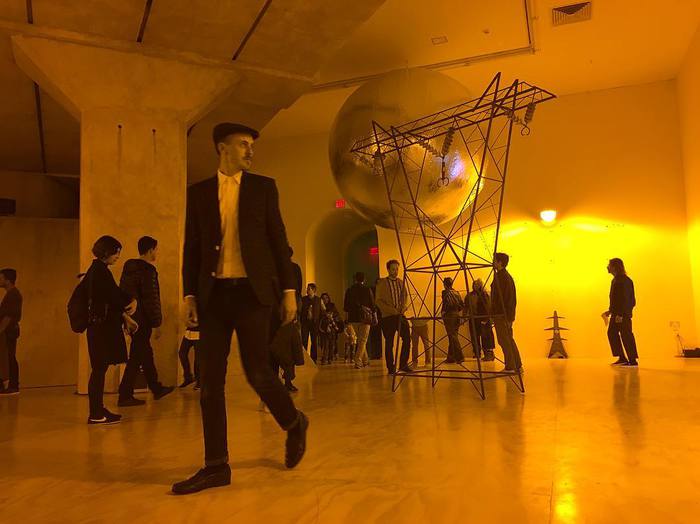
Mark Leckey and John Garcia included my work in shows that were totally fascinating and different from anything I could have imagined, which let me think about it and the world it inhabits in a new way. Having my satelloon sculpture be subsumed into Leckey’s autobiographically inspired installation at MoMA PS1 turns out to be a rare privilege, to be able to help realize, almost literally, someone’s memory.
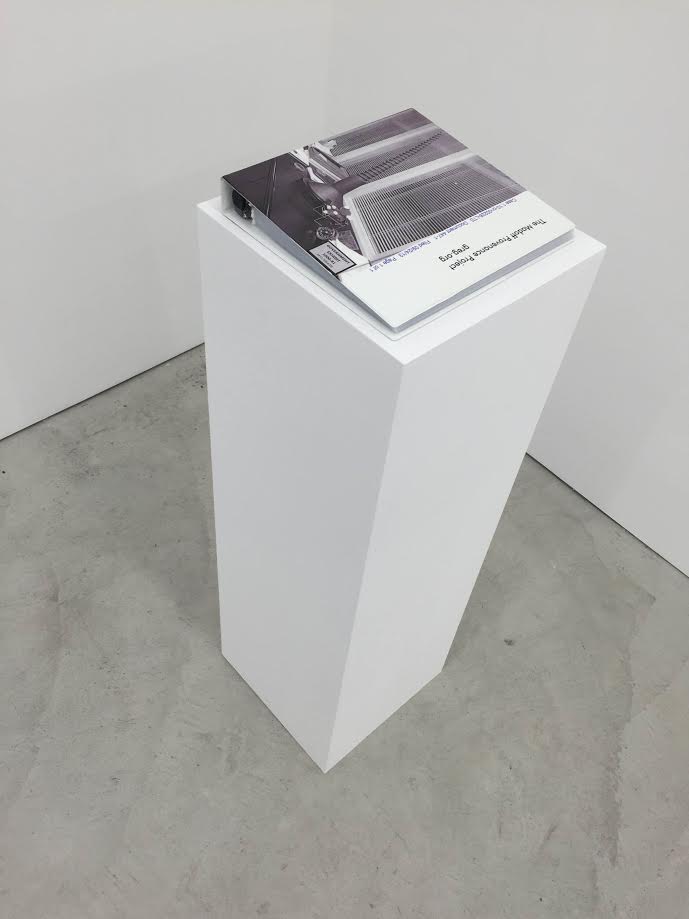
And Garcia’s inclusion of the Madoff Provenance Project in his show about context’s impact on art at To___Bridges___ not only gave it a challenging context, it pushed me to figure out ways to make the project visible and understandable beyond its datalayer. This in turn helped me see how my work connects to, and was informed by, artists of earlier generations. [In this case, there’s an obvious shoutout due to Mel Bochner and his Working drawings and other visible things on paper not necessarily meant to be viewed as art, a project whose title has long resonated with my own ambivalence about calling myself an artist or what I do art.]
Sarah Douglas and Andrew Russeth at ArtNews invited me to write about one of my favorite, all-consuming blogtopics: the disappearance of the Johns flag in Short Circuit. And recently Eric Doeringer and I had a great public conversation about his work, and the early Johns/Rauschenberg era that I continue to find engrossing and misunderstood.
Collectors and supporters who engage in the oddball, time- and space-limited art projects I proposed around here literally made them happen. In the crazy-skewed art world of the moment, lowering the stakes and making and trading art for two figures feels refreshing. And most awesomely, these projects have been a catalyst for connecting with some inspiring people who share some interests, and who introduce me to their passions and practices, too. [I hope 2017 lasts long enough for me to do a book version of eBay Test Prints, btw.]
Most of all, I have to thank my wife, who is my smartest, most skeptical, yet most tireless supporter. She is so deeply disapproving of my #andiron-style art designation practice it is not even funny, but she also sees me wrestling with it myself and taking it seriously, so she does, too. And anyway, at the very least, when I’m dead and gone, and she doesn’t have to deal with a storing or tossing a studio or warehouseful of objects, she’ll come around. So thank you, and thank you all. I hope we all get through 2017 and beyond to do this again.
Category: editing
Kenny From The Block: A Capital X Arcades Project Showdown
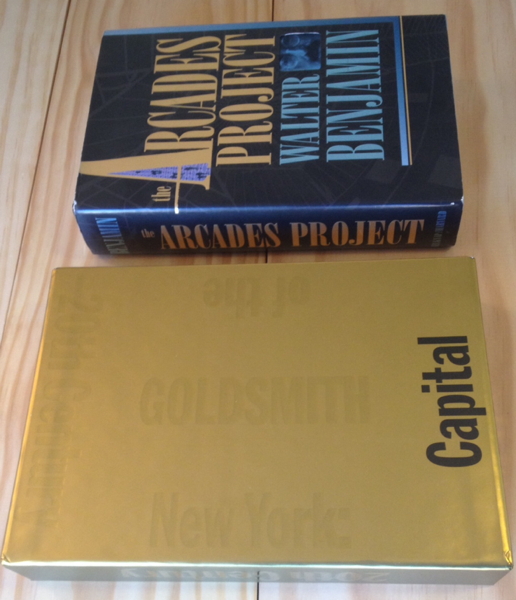
I was going to post an actual review of Kenneth Goldsmith’s new book, Capital, then the attacks in Paris happened. And then I thought I would write about Benjamin’s The Arcades Project, which served as inspiration for Goldsmith’s compendium. But I found the texts about Paris that fascinated Benjamin to be completely unhelpful for the situation I was in. I lived and worked between New York and Paris for several years until 2000. I embraced the 1999 edition of The Arcades Project as a map into my adopted city. And now that map felt out of date.
This is all too much information, though, for what I have decided to do, since no one really needs my warm take on a book that is, by design, nearly unreviewable, about a city, New York, that is equally impervious to encapsulation.
So here is a mashup of Capital and The Arcades Project, excerpting texts from whatever page I turn to, in turn. Benjamin first, p. 306:
WB: Baudelaire
Baudelaire’s fatalism: “At the time of the coup d’état in December, he felt a sense of outrage. ‘What a disgrace!’ he cried at first; then he came to see things ‘from a providential perspective’ and resigned himself like a monk.” Desjardins, “Charles Baudelaire,” Revue bleue (1887), p. 19.
Baudelaire-according to Desjardins-unites the sensibility of the Marquis de Sade with the doctrines of Jansenius.
…
KG: Food-Chinese
Americans looked on with wonder and asked him what the name of the food was that his chef was preparing. His answer was “Chop Suey” which meant that it was a combination of mixed foods. He explained that it was a meal consisting of bean sprouts, celery and Chinese greens, plus amy more vegetables, with a touch of meat, usually pork. The guests begged him to let them taste it. They did. Immediately they clamored for more. Overnight, Chop Suey won widespread popularity.
Chinese residents in New York soon found a new field of endeavor open to them. They opened restaurants and called them “Chop Suey Houses.” Many of these original Chop Suey Houses still exist.
Continue reading “Kenny From The Block: A Capital X Arcades Project Showdown”
Force Luke The Use: Star Wars Alphabetized, By Tom 7
OK, this is quite good. Tom Murphy 7 just released ARST ARSW, all the dialogue of STAR WARS Episode IV: A New Hope re-edited into alphabetical order.
I just watched the whole thing while clearing my inbox, and it is surprisingly interesting. Surprising, I guess, because the concept’s instant graspability seems seductively complete. You think you get it.
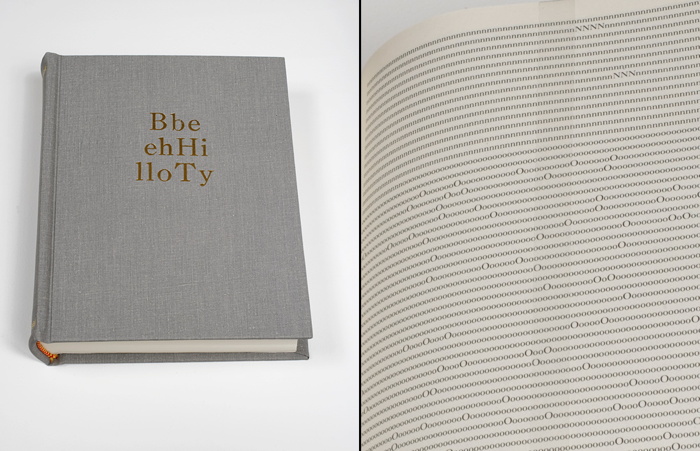
Tauba Auerbach’s Alphabetized Bible (2006) [above] is a bit like that. By alphabetizing the letters instead of the words, Auerbach atomizes not just the meaning of the text, but any hope of meaning at all. It becomes an object made of symbols, signifying nothing.
But that’s not what Tom 7’s film turns out to be. Even chopped so finely, the text, plus the film image and sound, still carry a lot with them. And since the fulltext of Star Wars saturates people more fully than the fulltext of the Bible, the experience of watching ARST ARWS is one of constant recollection and recognition. It feels like watching an actual movie, even though its structure has been obliterated. Not obliterated, but replaced. And that structure turns out to have surprises, tension, and meaning of its own.
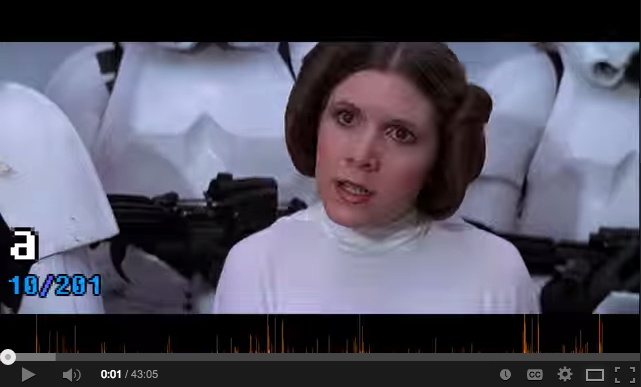
To be honest, it starts out slow and kind of muddled with “a,” a word that barely gets its sound right in 201 citations. The first real drama, as Kenny Goldsmith noted, comes with the 20 mentions of “Alderaan.”
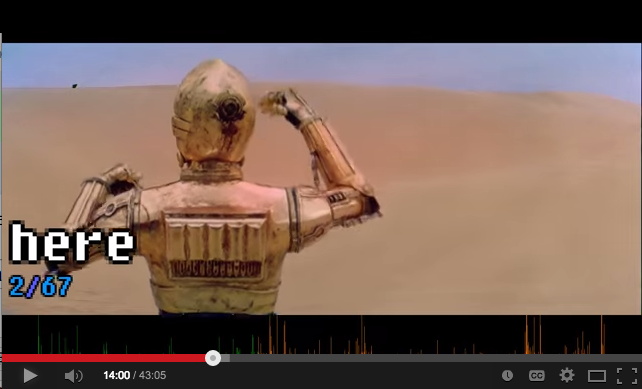
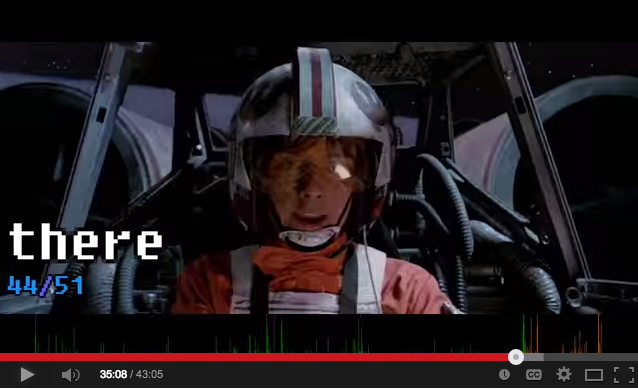
I did not expect it, but “hey” [19], “here” [67], and “there” [51] were very exciting, appearing in scenes of recognizable cinematic immediacy.
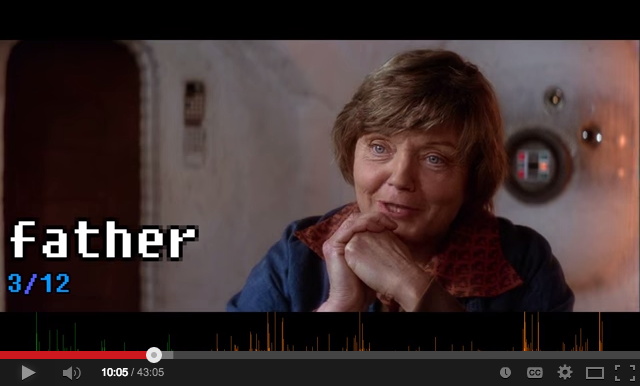
“Father” [12] was almost always said with unhurried purpose, which makes sense, but not with any systematic foreshadowing, which would have been brilliant. [And not beyond notice. According to Wookieepedia, Lucas tweaked the audio in a line of Aunt Beru’s for the 1997 Special Edition: “The line ‘Luke’s just not a farmer Owen. He has too much of his father in him.’ There is a slight pause before she says father and the word “father” is changed to sound more worrisome.” There are, however, no pauses in ARST ARSW, so this change is difficult to register here.]
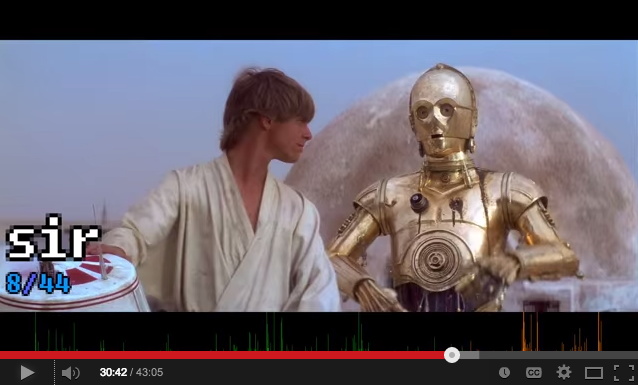
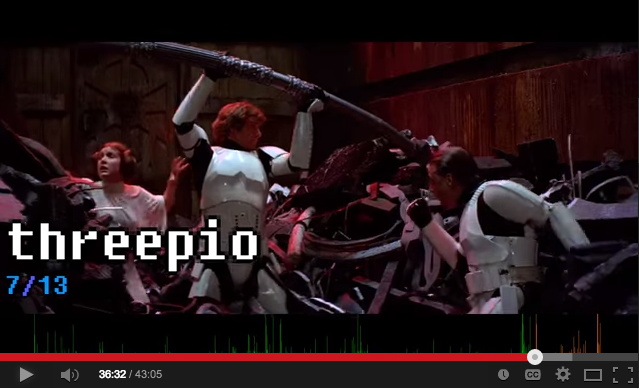
And there are a couple of standout solos [no pun]: C3PO’s “sir” [44] aria gets a response a few minutes later when mostly Luke mostly screams “Threepio” [13]. And though it’s only said once by anyone, Han really makes “worshipfulness” count. Tom 7 himself notes that “lightsaber” also only appears one time. “Death Star,” meanwhile, is two words, and so it dissolves into “Death” [6, but at least one is “death sentence” from the cantina], and “Star” [11].
Like any good film, ARST ARSW leaves you wondering how it was made and eager to see what comes next. The project has yet to appear on Tom 7’s site, but I expect the making of involved some tricky data scrubbing to sync each word with each clip. I’m guessing the subtitle file was used, but anything beyond that’s still in the movie magic category for me. [update: YOW, in the YT comments, Tom says he labeled all the words manually using purpose-built software!]
What I would like to see, though, is the data. Now that every word is synched to every clip, it can be released for remixing. Turn Star Wars into a database for generating whatever text you can imagine.
This has already happened, of course, with news footage, where there’s a whole genre of YouTube videos of remixed presidents saying things they didn’t originally say. The ultimate example for me is still Dan Warren’s 2011 breakthrough, Son of Strelka, Son of God, a mythical epic woven out of Barack Obama’s audiobook recording of Dreams of My Father.
If Tom 7’s process for turning movies into words can be scaled, we won’t need to stop at Star Wars; we could turn every clip of everything into the raw material for anything.
ARST ARSW: Star Wars sorted alphabetically. [youtube]
Son of Strelka, Son of God, by Dan Warren
When People Die, They Sing Songs: Chris Marker’s Stopover In Dubai
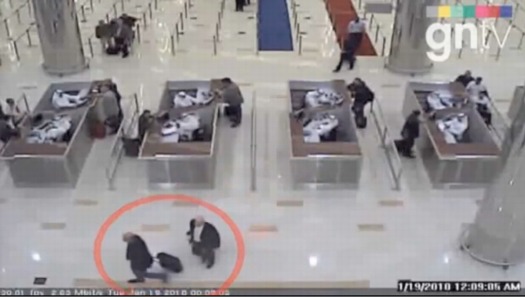
As soon as I learned of Chris Marker’s death, I went to look at what I’d written about one of his most recent projects, which I’d been so stunned by, only to find that I hadn’t written anything at all, only tweeted about it, which is barely more persistent than thinking about it.
And I don’t mean Marker’s show of surreptitious Metro chick photography at Peter Blum last year, which was cliched to the point of embarrasment. It’s the short Flash video Stopover in Dubai, which appeared almost unannounced on Gorgomancy, a pseudonymous Marker website. [I prefer the direct link to the .swf file (2025 update: they’ve switched to mp4 and ogv.)]
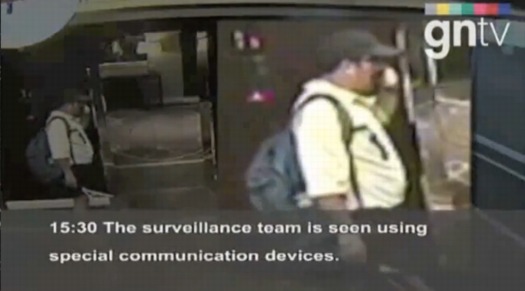
For all i thought I knew and admired about Marker’s work, from the touchstones of La Jetee and Sans Soleil, up to the improbable Immemory CD-ROM, Stopover In Dubai stopped me cold. But not [just] because of the content, though it is chilling.
Stopover in Dubai is the meticulous reconstruction of a Mossad hit squad’s surreptitious mission to assassinate Hamas military commander Mahmoud al-Mahbouh in his hotel room on January 19, 2010. The entire thing plays out silently, via CCTV surveillance video from all over the city. Not that anything actually ever “happens” in front of the cameras; the footage only shows the most seemingly banal images of people crossing hotel lobbies or waiting for elevators.
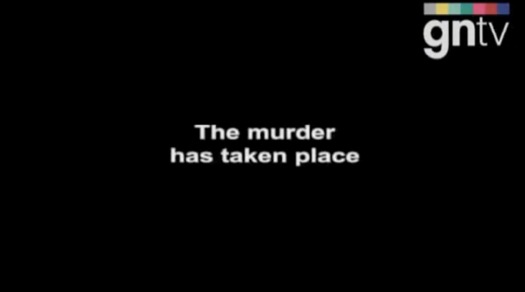
The footage was available because the show was actually assembled, not by Marker, but by Dubai’s General Department of State Security, as part of their investigation of Mahbouh’s death. The riveting, 26-minute account of the hit, titled, The murder of Mahmoud Al Mabhouh, was provided by the government to Gulf News TV, the video news service of the UAE’s leading English language newspaper.
It was only after watching Stopover in awe, figuring out what it was, and then tracking down and watching the original version, that I realized Marker had appropriated GNTV/Dubai State Media’s footage exactly as they aired it, edits, captions, graphics and all. And yet he had completely remade the film. Marker replaced the news program’s generic, royalty-free, techno-lite soundtrack with a haunting, ominous string composition written by Henryk Górecki for the Kronos Quartet.
The music seems to fit perfectly, like it had been written, scored, or at least timed, to the film. Until I started digging, I’d assumed Marker had used segments of another film score, the way he’d mashed up this riot slideshow by the Times of London with music from The 400 Blows. But Marker actually just plays Górecki’s piece, “String Quartet No. 3 (‘…songs are sung’)” straight through.
Where I’d once questioned my interpretation and response to the film, wondering who was actually responsible for the elements of its success-its narrative, structure, pacing, and suspense–I now marveled at Marker’s ability to recognize how these two things existing in the world–the edited footage and the Kronos recording–resonated so powerfully with each other, and with himself and his artistic sensibilities. Marker didn’t need to do any more than make this impossible connection; it was the slightest gesture necessary, and yet the result is no less remarkable.
I don’t know if Marker saw it–maybe it’s in the liner notes for the Kronos CD–but a Nonesuch text complicates the relationship between the Górecki composition and the Mahbouh assassination in unexpectedly poignant ways.
GNTV’s opening titles tell us that the Mossad had been pursuing Mahbouh for years without success. Kronos, meanwhile, had originally commissioned Górecki to create a third work for them in 1992, and it was set to debut in 1994. But nothing came. For over 13 years. The composer finally delivered the work in 2005, with a dedication,
“To the Kronos Quartet, which for so many years has waited patiently for this quartet.” In a commentary attached to the score, Górecki added that the work had been completed in 1995, “but I continued to hold back from releasing it to the world. I don’t know why.”
The quartet’s title, meanwhile, “is inspired by the last line of a poem by the Russian poet Velimir Khlebnikov, ‘When people die, they sing songs.'”
Just as Kronos’ long, patient wait for its song resonates with the Mossad’s long-fruitless hunt for vengeance/death, the suspenseful score of a found footage, real life spy thriller is revealed as the song the target–who barely appears in the movie itself–sings when he is drugged, paralyzed, and smothered in his hotel room, out of the cameras’ view, but still within the auteur’s reach. Who was, in this case, Chris Marker.
Star Wars: The Topher Grace Edit
As part of his study of the art of editing, and to do good for all mankind, the actor Topher Grace recut Star Wars episodes 1-3 into an 85-minute prequel which focuses on the transformation of Anakin into Darth Vader. Paul Sciretta attended a secretive screening of the Grace Edit, and prepared a detailed write-up for Slashfilm. Given what Grace had to work with, the remix sounds pretty good. But then there’s this:
Before the film screened a trailer for another film Topher Grace is remixing — Steven Spielberg’s Close Encounters of a Third Kind. I’m not sure that film needs a remix, or could even benefit from a remix, but am interested to see what the experiment will look like. After that, Grace hopes that other actors, editors and filmmakers will run with the ball, produce and showcase remixed films on a annual basis within this private community.
Jason Reitman has been directing live stage reads of classic film screenplays at LACMA, showing how a filmmaker can make different choices with an interesting cast can completely change a written screenplay. This seems like the next evolution of that, but also an exercise in storytelling with the use of crafty editing. I’m not sure I completely understand Grace’s motives in creating this film, but I enjoyed it regardless.
Close Encounters has already gone through several notable edits, as Spielberg tinkered with it. [The director himself considers the 2001 Collector’s Edition to be the definitive version.]
I’m kind of fascinated with this idea of using commercial films and their inputs as raw material, and especially with seeing people inside the Hollywood bubble, who are likely to be indulged rather than sued, softening up the crowd. I may get around to making my shot-for-shot remake of Gus Van Sant’s Gerry yet.
Topher Grace Edited The ‘Star Wars’ Prequels Into One 85-Minute Movie and We Saw It [slashfilm via umm,
Son Of Strelka, Son Of God, By Dan Warren
While I was painting today, I first listened to a slightly underwhelming Q&A from MIT with Otto Piene and Hans Haacke, which was short, and so my iTunes started shuffling, which never happens. I don’t really listen to music, so iTunes ends up being a repository of things I wanted at one point–but then pretty much didn’t listen to. Like the audiobook version of Barack Obama’s Dreams of My Father, 2-3 min. segments of which would turn up at random every few tracks.
Which reminds me, kind of hilariously, of what, for me, is one of the most remarkable artistic achievements of the year, the awesomeness of which may actually push me to make a best-of list, which I don’t like to do, just so I can put it where it belongs, near the top.
I’m talking, of course, about Dan Warren’s remix masterpiece, Son of Strelka, Son of God, a surreal, mythological epic about a dog-headed demigod who destroys, and then recreates, the world, which Warren created by stringing together 3-10 second snippets from Obama’s recording. Here’s the synopsis:
Our hero’s name is Stanley, but he doesn’t really show up until Chapter 3. Stanley’s father is the first proto-man, who fell as a fruit from the first tree. He found the world an empty and desolate place, so he climbed to the top of the tree and began creating animals and plants and whatnot just by speaking their names. He gets really excited about the process, and accidentally creates a monkey in thin air, which promptly plummets to his death. He realizes that he needs to be a little more thoughtful about this process, and finishes by creating many of the beautiful things in the world. Then he disappears.
The first of the story’s nine chapters was animated by Ainsley Seago; the whole thing is pulled together nicely by Atlanta DJ EBA’s soundtrack. The whole project’s just extraordinary and feels like the future.
Son of Strelka, Son of God audio odyssey, links + a synopsis [sonofstrelka.com]
download Son of Strelka, Son of God for free from Warren’s site [dannwarren.net]
Wow, The Unseen Original Ending From Alexander Payne’s Election
Wow. It’s amazing how awkward and wrong this original ending to Alexander Payne’s 1999 feature Election seems. According to Peter Sciretta at Slashfilm, this six-minute segment comes from a VHS transfer of an original work print found at a flea market. The ending tested so badly, Payne went back to shoot additional footage for the more satisfyingly harsh ending he released.
Sciretta notes that there’s never been any discussion of another ending to the film, but hey-ho, It’s right there in Payne’s and Jim Taylor’s original script.
Watch The Never Before Seen Original Ending of Alexander Payne’s ‘Election’ [slashfilm via matthew clayfield]
Previously: I co-hosted a MoMA Film Dept. party for Alexander Payne in 2003. more recapping here.
The Sun Never Sets On Your Richard Prince Depositions Shopping Cart
You know what, in my six days as a published author, out there flogging his book, I find myself thinking, again, of Cervantes and Don Quixote. I mean, I it really feels like I’m living in the Quixotian name I gave my film production company, First Sally.
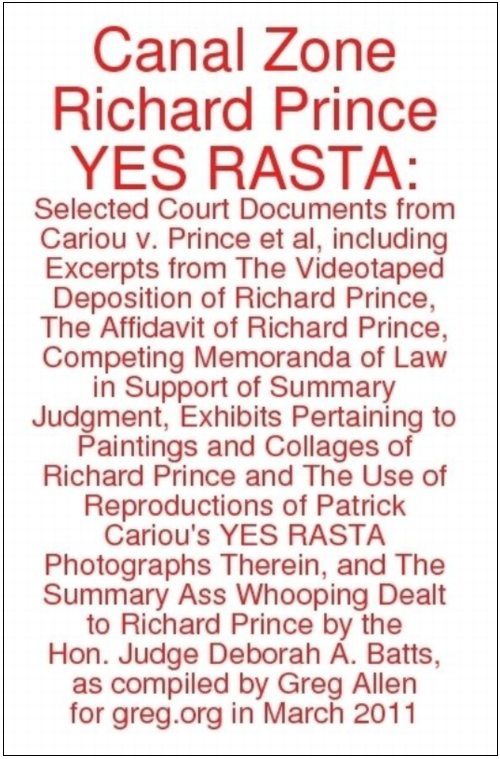
The cover on the paperback edition of Canal Zone Richard Prince Yes Rasta: Selected Court Documents, &c., &c., 290 pages, $16.99
And so as I was reading Jonathan Gharraie’s post in The Paris Review, I couldn’t help but but note all the striking similarities between Canal Zone Richard Prince Yes Rasta: Selected Court Documents, &c., &c., my critically considered selection of Richard Prince’s deposition transcripts and legal filings, and Cervantes’ work. I mean just think about it:
- Both Prince and Quixote mildly shock their guests at exhibits on the Upper East SIde.
- Quixote was recently republished in a carefully crafted illustrated version by a legendary artist press; I carefully assembled the Canal Zone… PDF by hand before uploading it to lulu.com.
- Quixote’s idealistic fantasies are enabled and indulged by an all-powerful Duke for his own bemusement and enrichment; Prince shows–and goes to court with–Larry Gagosian, on whose gallery the sun never sets.
- Cervantes gave his book one of those funny, old-timey, super-long titles; I, well, just look at the cover of the paperback edition.
I could go on and on, to the point I stop debating whether I’m Quixote or Cervantes, and begin wondering whether I’m Pierre Menard or Borges. I assume all authors go through this.
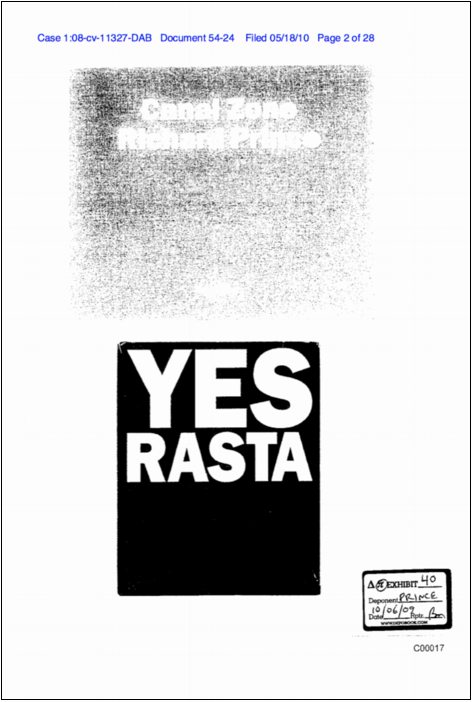
Canal Zone Richard Prince Yes Rasta: Selected Court Documents, &c., &c. in hardcover, 290 pages, $24.99 [updated link, see below]
More info on Canal Zone Richard Prince Yes Rasta in the original post.
See a couple of sample spreads from the electronic edition.
Anyway, Gharraie sums up nicely the digital future where artisanal books still thrive in a tablet world:
If anything, I would rather have it both ways: the book and the blog; the lavish endeavor of the lovingly prepared new edition and the take-out convenience of the virtual text.
And I humbly announce that the future of both art and literature is here. Now if you’ll excuse me, I have to get to work on my book trailer.
APR 2011 UPDATE: The hardcover is temporarily unavailable, but there is a new, expanded softcover edition, which now contains Prince’s entire deposition transcript, an additional 101 pages, plus other key legal documents. Also, it’s from a new, nicer printer.
Canal Zone Richard Prince YES RASTA: Sample Spreads
Thanks for the support and feedback on the Canal Zone Richard Prince YES RASTA: Selected Court Documents &c., &c. book. [updated link info below]
Some folks who ordered the electronic version–the first to get the compilation in their hands, since the print editions take a few days to arrive–have emailed wondering where “the rest” of Richard Prince’s deposition transcript is, because there are gaps and missing pages.
That’s exactly right, and it’s why I decided to make this thing in the first place. As far as I can tell, the entire 378-page transcript of the 7-hour deposition was not entered into the court record, only the excerpts that pertained to quotes or points referenced in the two sides’ various legal motions. As I was reading those scattered snippets in various places in the court record, I realized it would be more useful to have a single compilation of all Prince’s testimony. And it’d be easier if it was in order. So I took apart the pdfs and sorted the pages, then interlaced the other exhibits [i.e., images from Cariou’s book and Prince’s show and catalogue] as they came up in the course of testimony.
Here are a couple of sample spreads taken from my original [sic, heh] pdf. There are about 250 of these transcript pages in total, four per printed/pdf page.
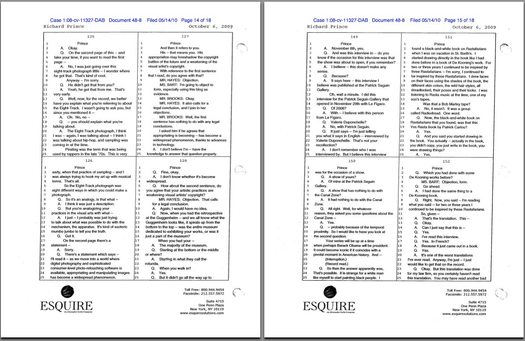
pp. 125-8, 149-152
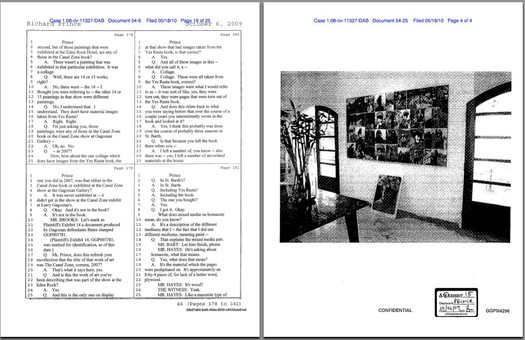
pp. 178-181 and Exhibit 15, installation shot at the Eden Rock Hotel, St. Barth’s
APR 2011 UPDATE: Here is the link to buy the new, expanded edition, which includes Prince’s entire deposition transcript–an additional 101 pages–plus other key legal documents. It’s a new printer, and the finish of the book is nicer, I think.
Canal Zone Richard Prince YES RASTA: The Book

from greg.org: Canal Zone Richard Prince YES RASTA: Selected Court Documents, &c., &c. in
hardcover, 290pp. $24.99 [updated link info below]
Because really, why not?
It’s always bugged me when I read a news story about a legal case, or a scientific report, and there’s no link to the original source material. And since I’ve been quoting from them a lot lately, I have been fielding a lot of requests for copies of the court filings and transcripts in the Patrick Cariou vs. Richard Prince & Gagosian case.
It was yesterday afternoon, though, when I was sending my fourth email [or eighth, since the attachments are so big] that I realized Richard Prince’s deposition is not only the longest interview he’s ever given, it’s probably the longest interview he’ll ever give. [Go ahead, Hans Ulrich, you just try!]
I mean, seriously, the guy talked for seven hours. Under oath. In insane detail about his work, process, and ideas. Granted, he was being grilled by a guy whose art ignorance is only surpassed by his obvious contempt for Prince, a lawyer who can’t tell a photograph from a painting from a reproduction in a book. But still, he got Prince talking.
And Prince was surprisingly [to me, anyway] and admirably consistent and credible, at least in terms of his work. Yeah, it’s a nice bit of fact-checking trivia to strip away the coy mystery crap that surrounded his Guggenheim retrospective: Prince testified that he is Prince, and that he did live in the Panama Canal Zone, but only as a very young child.
But I found his explanation of his early formative inspirations, particularly Warhol and punk rock, to be both relevant and sincere. The deskilling argument that you could pick up a guitar for the first time, and by the end of the week, go up on stage and perform, with visceral effect, sounds real to me. It makes sense, at least in its own context [and in my own high school experience.]

The cover of the paperback edition includes the full title. 290pp 376pp, $17.99
Anyway, Prince’s entire deposition transcript has not been released [update: it has now; see below], but a patchwork of 250 or so pages out of about 375 were attached as supporting documents to various filings and motions in the case. So I sifted through and pulled them all out, and then placed them in numerical order. There are a lot of gaps, of course, and legalistic joustings, but there’s a lot of information, too.
Combined with his 28-page affidavit, it really is the most extensive discussion of his work, practice and biography I’ve ever seen Prince make. The fact that it’s all coming out in the context of a copyright infringement lawsuit is really too perfect to pass up.
Into this I wove the major documents and exhibits Cariou’s lawyers discussed with Prince: all the Canal Zone series paintings; installation shots from the Eden Rock hotel in St. Barth’s; Prince’s “Eden Rock Pitch,” a rough movie treatment whose characters and story fed into the paintings; and Cariou’s extensive visual comparison of Prince’s Canal Zone paintings and the YES RASTA images that ended up in them.
And for good measure, I added both sides’ memoranda, where they make their fullest legal arguments for their fair use/transformative use and copyright infringement positions. And of course, I included Judge Batts’ ass-whooping of a ruling.
In all, 290 pages, all taken–appropriated, one could say–from the court record, but organized into a clearer, more readable format. And with a focus, not on an exhaustively documenting the case itself, but on Prince and his work.
If you were to download all of this material from pacer.gov, it’s run you upwards of $24 [$0.08/page]. And then you’d still have to sort it all out. For that money, I thought, you could have a nicely printed book. And so that’s what I did.
There are hardcover and paperback editions, and electronic copies, too, which I haven’t tested yet. I’m still tinkering with the cover design. Both versions are included inside the book, as frontispieces or title pages or whatever, but right now, the b/w cover cover is on the hardcover, and the red, made-with-Preview’s-default-annotation-settings version is on the softcover.
This is definitely an experiment, so any and all feedback is welcome. But if you’re looking for the perfect book to take to spring break, or to class up your summer share, then you have come to the right place. Enjoy!
Buy your own copy of Canal Zone Richard Prince YES RASTA: Selected Court Documents, &c., &c. in or in paperback [$17.99]. [createspace.com]
hardcover [$24.99]
APR 2011 UPDATE: OK, the response to this book really caught me off guard, so I’ve done some more work on it. The new, expanded edition now includes Prince’s entire deposition transcript, an additional 101 pages of testimony not previously released publicly, and several additional key legal documents from each side. In addition, while lulu.com was a quick and decent way to release a book almost instantly, I decided to switch to a higher quality printer for the new edition. The facsimile pages are a little smaller, which I’m still working on, but the quality of the book is noticeably higher. It now clocks in at 376 pages, for $17.99.
The Gala As Art As Slideshow
The Gala As Art, greg.org, at #rank 2010 from greg allen on Vimeo.
Here’s the narrated slideshow I did at #rank during Art Basel Miami Beach.
Many thanks to Jen and Bill for inviting me, to Magda for instigating, to all the SEVEN galleries for hosting, and to Michelle Vaughan for sharing her sharp gala insights. And a huge thanks to Jean, whose advice helped structure a drive-by blog post into a more coherent [I hope] argument. And who insisted I go do the talk, even though it meant celebrating our tenth anniversary early and late.
Thanks, too, to the artists and photo sources, including, in random order as I think of them: Andrew Russeth/16miles.com, Artforum.com, Andrea Fraser, MoCA, LACMA, the Rubell Family Collection, Jennifer Rubell, Kreemart, Christoph Brech, Getty Images, Patrick McMullan, the daily truffle, billionaire boys club, Vernissage TV–don’t these credits make you just want to hit play right this second??
The audio’s rough, the aspect ratio wonked out at the last minute, and I’d do better to just rebuild the whole thing rather than adapt my Keynote slides. And while there’s no gift bag at the end, I did manage to edit out a whopping 12 minutes of um’s, pauses, and “wait, I want to go back to the previous slide”s. I guess media training is NOT like riding a bike.
John Cage’s One11: The Making Of, Now In English
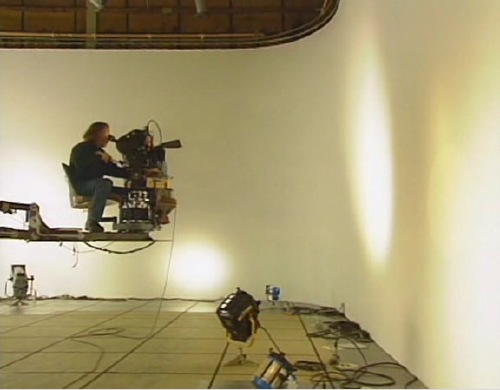
A couple of weeks ago, I watched Henning Lohner’s film essay/documentary about working with John Cage to make One11 and 103, Cage’s only feature film project, completed just before he passed away in 1992.
It’s on YouTube, chopped up in several parts, and mostly in German [One11 and 103 was made for German TV], but now Ubu has posted the English version, so you non-Germans can actually figure out what’s going on. [ One11 and 103 is online, too, though it has the 3sat logo burned into the upper corner, which turns the whole thing into a 90-minute promotional bumper for the station.]
For One11, Cage and his collaborator Andrew Culver used a computer program to generate a series of chance operations, instructions for light placement and movement within an empty soundstage; for camera movement and positioning; shot length; and for editing.
Narrative- and nearly content-free, the 17-segment film was accompanied by 103, a 17-segment orchestral composition that was also based on chance operations. The film’s title follows Cage’s numbering system: the eleventh composition for one performer, in this case, the camera man. So while Cage explains the film as being “about the effect of light in a room,” it’s also very much about the perception, movement, and recording of the cinematographer, Van Carlson.

Cage made the point to Lohner early on that his idea wouldn’t “waste” any film. And sure enough, it turns out the final shooting ratio was an astonishing 1.4:1, with less than 600 meters of extra footage–which, we are told, was used in the opening and closing credits. It’s almost like Cage went to film school during the Depression.
The obvious appeal of an abstract light show aside, watching all this self-conscious randomness [I’ve been going through and replacing “random” with “chance,” since that’s the specific term Cage uses. I think there’s a meaningful difference.] really puts the conscious decisions of location and content into high relief. It also makes me want to remake One11 in another environment and see what happens. I’d also wonder how many more decisions could be randomized, and to what effect? Eventually, if you put a decision factor into play, the randomness of it will generate a distinctive effect, if not an actual style. It’s one of the conundrums of Cage’s work that I like picking through.
One11 and 103: the making of [ubu.com]
You know, at $27, it wouldn’t kill you to buy Mode Records’ DVD version of John Cage: One11 with 103, either, from The Complete John Cage [amazon]
NOW THAT I THINK ABOUT IT UPDATE: You know, posting this really seems like a departure for Ubu. I mean, Ubu began posting vintage, impossible-to-buy-or-even-find works, but with One11 and 103, they basically ripped a commercial DVD published in 2006 by a small, well-known, high-quality independent publisher of modern music. Am I missing something here?
UPDATE UPDATE: Yeah, Ubu’s versions of both One11 and Making of One11 first appeared on The Sound of Eye, an equally amazing art film and experimental music blog, albeit one with a different approach to posting works that are readily available in the commercial market. Ubu announced a collaboration with Sound of Eye a little while ago.
‘The Sound of Footsteps’
Tacita Dean on the making of Craneway Event, the rehearsals of the Merce Cunningham Dance Company in a former auto factory on the San Francisco Bay, which she filmed exactly a year ago:
I edited it alone on my film-cutting table using magnetic tape for the sound, which means you have to continually mark everything to keep the film in sync. The sound and image are separate, and the moment you lose sync it’s a nightmare: It’s just the sound of footsteps, which could be from anywhere in the film so it’s nearly impossible to find sync again.
17 hours of film edited down to 1h48, which fits nicely with the “longueur of some of [her] other films.” Looks and sounds fantastic.
Tacita Dean | 500 Words [artforum.com]
Craneway Event premieres Nov. 5-7 at St. Marks Church as part of Performa 09. [performa-arts.org]
Astute And Observant Viewers Get Fischli & Weiss
It just keeps going and going! From Steven Kaplan emailed with a reply from MoMA curator Christian Rattemeyer about the consciousness of edits in Fischli & Weiss’s Der Lauf der Dinge: “It is his contention that many astute and observant viewers (himself included) have ‘always thought of it as an edited work, never as a continuous chain reaction.'”
D’oh! If you need me, I’ll be over here in the unastute and unobservant section, reading People. But to Kaplan’s–and by extension, Rattemeyer’s, and the entire observant art world’s–point, I didn’t mean to imply that Fischli & Weiss have duped anyone, or that they or any institutions are mis-presenting the piece.
Editing is basic to the language of film, so basic, in fact, that it often disappears from our consciousness. That’s just the way things go. Just as Fischli & Weiss’s meticulously fabricated re-creations of a custodian’s closet, Der Lauf der Dinge‘s impact derives from its seemingly artless [sic] matter-of-fact-ness. It looks and feels like a documentary, just a guy with a camera capturing the way things go. But it turns out to be a film that–like any other film–is the careful culmination of a whole host of aesthetic decisions, both on the set and on the editing table. Maybe the editing point is so obvious, it doesn’t need to be made, but I guess I’m simpleminded like that.
[update after thinking about it: Though F&W’s edits are not cuts, the kind of jumps of time, place, or vantage point we’ve come to read unconsciously as film; they’re almost all illusionistic, dissolves and fades, that attempt to approximate continuity.]
Rattemeyer also brought a show at Susan Inglett Gallery to Kaplan’s attention, titled “The Way Things Go,” in obvious homage. It closes tomorrow, so I’ll have to content myself with the press release and images.
The Way Things Go, through Dec. 20 [inglettgallery.com via thing.net]
Vik Muniz Gets Fischli & Weiss
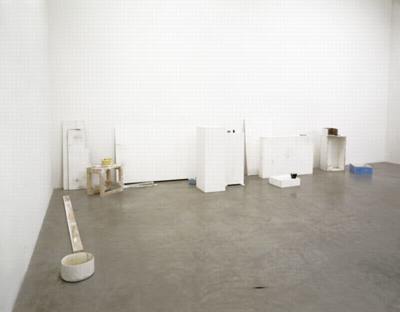
I’ve been searching for more critical acknowledgment of Fischli & Weiss’s Der Lauf der Dinge as an edited construct instead of the miraculous documentation it’s normally perceived/presented to be.
Though he’s talking about another Fischli & Weiss piece [above], artist Vik Muniz, who just curated Der Lauf der Dinge into “Creating a Rebus,” his show at MoMA, nails some very relevant aspects of the duo’s work:
It’s about this connection between mind and matter — how something is conceptual and formal at the same time. Fischli and Weiss are artists that I admire for this: They manage to put an enormous amount of craft into their illusions. I remember when I first saw this piece at Sonnabend Gallery, people didn’t think these objects were constructed, but they are all cast pieces. It takes a lot of labor to make something look accidental.”
Vik Muniz on Creating a Rebus [artinfo.com, image: matthew marks gallery]
update: In a short podcast with Mexican artist Pablo Helguera, Hirshhorn curator/researcher Ryan Hill mentions F&W’s dissolves a couple of times, and how exhibiting the film on a loop can trap visitors who keep watching the procession go round and round. I don’t know why there’s no way to search, sort of link directly to the many, many podcasts on Hirshhorn’s site, but here’s the mp3 file [hirshhorn.si.edu]
